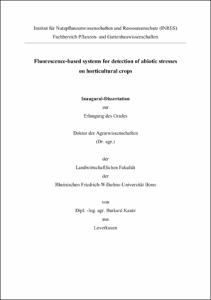Kautz, Burkard: Fluorescence-based systems for detection of abiotic stresses on horticultural crops. - Bonn, 2016. - Dissertation, Rheinische Friedrich-Wilhelms-Universität Bonn.
Online-Ausgabe in bonndoc: https://nbn-resolving.org/urn:nbn:de:hbz:5n-43356
Online-Ausgabe in bonndoc: https://nbn-resolving.org/urn:nbn:de:hbz:5n-43356
@phdthesis{handle:20.500.11811/6606,
urn: https://nbn-resolving.org/urn:nbn:de:hbz:5n-43356,
author = {{Burkard Kautz}},
title = {Fluorescence-based systems for detection of abiotic stresses on horticultural crops},
school = {Rheinische Friedrich-Wilhelms-Universität Bonn},
year = 2016,
month = may,
note = {The main objective of this thesis was to assess the impact of economically important abiotic stresses on the plant physiology using non-destructive fluorescence indices, and to evaluate the potential use of the sensor techniques as supporting tool for plant phenotyping in horticulture. The early detection of water deficiency and salinity was studied at leaf level in tomato (Solanum lycopersicum L.) plants by means of non-destructive fluorescence techniques. Evaluations comprised multiparametric fluorescence indices and pulse-amplitude modulated (PAM) chlorophyll fluorescence parameters for an effective and rapid sensing of water deficiency stress and stress recovery in three tomato genotypes. In addition, the impact of salinity on tomato genotypes was also studied using both methods. In the next step, the response of tomato genotypes exposed to simultaneous occurrence of salinity and water deficiency was examined by multiparametric fluorescence indices. An additional objective of the work was to investigate the suitability of chemically induced osmotic stress by polyethylene glycol (PEG) for drought stress experiments based on key physiological parameters of apple (Malus domestica Borkh.) leaves.},
url = {https://hdl.handle.net/20.500.11811/6606}
}
urn: https://nbn-resolving.org/urn:nbn:de:hbz:5n-43356,
author = {{Burkard Kautz}},
title = {Fluorescence-based systems for detection of abiotic stresses on horticultural crops},
school = {Rheinische Friedrich-Wilhelms-Universität Bonn},
year = 2016,
month = may,
note = {The main objective of this thesis was to assess the impact of economically important abiotic stresses on the plant physiology using non-destructive fluorescence indices, and to evaluate the potential use of the sensor techniques as supporting tool for plant phenotyping in horticulture. The early detection of water deficiency and salinity was studied at leaf level in tomato (Solanum lycopersicum L.) plants by means of non-destructive fluorescence techniques. Evaluations comprised multiparametric fluorescence indices and pulse-amplitude modulated (PAM) chlorophyll fluorescence parameters for an effective and rapid sensing of water deficiency stress and stress recovery in three tomato genotypes. In addition, the impact of salinity on tomato genotypes was also studied using both methods. In the next step, the response of tomato genotypes exposed to simultaneous occurrence of salinity and water deficiency was examined by multiparametric fluorescence indices. An additional objective of the work was to investigate the suitability of chemically induced osmotic stress by polyethylene glycol (PEG) for drought stress experiments based on key physiological parameters of apple (Malus domestica Borkh.) leaves.},
url = {https://hdl.handle.net/20.500.11811/6606}
}






